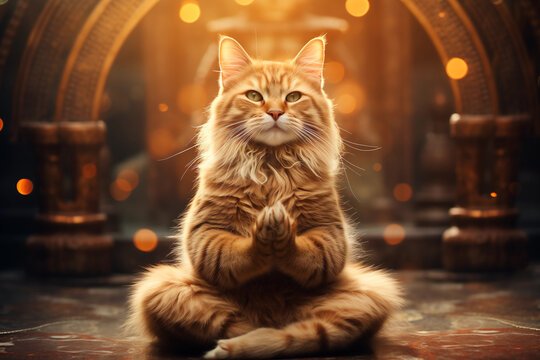Yoga Asana: Cat Pose or Marjariasana
Each posture in the physical yoga practice has a Sanskrit name ending in asana. Asana means seat or posture. Today we will explore Marjariasana also known as cat pose. When we break down the Sanskrit we see: Marjari which = cat and asana which = seat or posture. The history of cat pose is not clear. The cat pose we practice today is not found in historical text, yet there is another variation of cat described in the yoga text called the Haṭhābhyāsapaddhati (17th - 18th century) however, it is translated as upturned cat and while the shape of the spine is similar, the shape described in the text is performed lying on the back, more similar to apanasana or knees to chest pose. Regardless, cat pose is a helpful, accessible posture for most and is commonly practiced in a combination with cow pose. You will most likely hear instructors cue as if the postures are one, “let’s do some cat/cow.” Marjariasana is usually practiced as a warm up for spine mobility and in preparation for more intense back bends.
This brings us to the WHY behind Marjariasana. The big picture WHY behind all yoga postures is to develop a meditation ‘seat.’ Having the goal of “sitting” may not feel like a lofty goal, however, we could consider our “seat”to be the seat in our chariot of which we must ride to the gates of internal freedom. If we do not know how to sit in our chariot, we will spend our lives tinkering around outside the chariot wondering when the driver will be arriving. Asana is like our driver’s ed. for chariots. We must be prepared and our bodies must be able to handle the bumps, the bounces, and the turbulence that is sure to arise on our journey. Marjariasana creates spinal flexion which stretches the back body while strengthening the core body. This posture also has the potential to stimulate abdominal organs, increase circulation, relieve back pain, as well as improve posture. Because this posture is often practiced with cow pose, it also aids in spinal mobility, general awareness of the spine itself and its’ natural curvature, as well as promote coordination between breath and movement.
Marjariasana can have symbolic, metaphoric, and meaningful significance to our own personal why’s. When we consider the Sanskrit translation of the posture, marjari, stands out, which translates to cat. When you consider the essence of a cat, what comes to mind? Curiosity, playfulness, independence, confidence, perception, agility, flexibility, self-regulation. The cat has soooo many qualities that we are encouraged to develop to walk the yogic path. Which of these characteristics needs to be developed in your way of being? I currently have two kittens and their ability to play with EVERYTHING is inspiring. As adults, it seems quite common that we forget the importance of play. Can you recall the last time you felt silly, had a big ol’ belly laugh, skipped instead of walked, had a water balloon fight, made fart noises, tickled your partner, busted out your dance moves, howled at the moon or did something for joy versus pre-defined productivity? Or what about independence? What if you took yourself out to dinner and a movie, had a day of silence or a day of no social media? It is not morbid to acknowledge that we will one day have to walk through death’s door alone. When we consider the importance of developing ourselves with the qualities WE decide are important, versus the qualities society has told us will make us valuable, we will obtain a much deeper sense of inner peace. Rather than striving to be who we are told to be, we get to be who we are meant to be. And perhaps, we were meant to be cats?!, or at least I think I was!
How to do Marjariasana:
Come to all fours, hips over knees, shoulders over wrists or slightly forward of the wrists. Spread your fingers so there is space between each one and grip through your finger pads. Start with a neutral spine and notice the natural curvature of your back. Now bring your awareness to your tail and take an inhalation, on your exhalation start to point your tail down and round your spine. See if you can articulate this rounding from your low back to your middle back to your upper back. This will require you to draw your naval towards your spine and engage your core muscles. Allow your head to drop and your chest bone to move towards your pubic bone all while pushing the floor away from you. Pause when you are there and completely empty out your breath. On your next inhalation once again bring your awareness to your tail and start to tilt it back up towards neutral. See if you can return to neutral in that same progression from tail to head.
Once you establish a very clear cat pose, perhaps you begin to add cow pose. Continue to make your entry and exit the tail, while keeping your attention on the articulation of the spine from flexion to extension while acknowledging where is neutral.
Modifications
For sensitive knees, place a blanket under the knees or double fold your mat or use a knee pad.
For sensitive wrists, make your hands into fists, with the thumb part of the hand facing forward or bring your forearms onto blocks.
Variations:
Bring your forearms down onto the mat and proceed with cat.
Perform the cat from a seated position, standing on your knees, or standing position. There are many different arm variations you can incorporate to explore the sensations in your spinal flexion.
***Permission to modify in anyway that provides you with a feeling of safety, ease, and is alignment with your purpose in practicing the posture.
Muchas Gracias Dear Reader,
May the essence of the cat inspire your daily being.
Blessings,
Andrea Dawn

